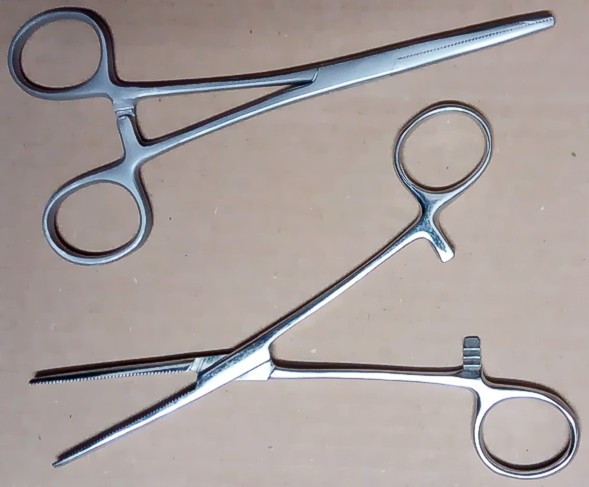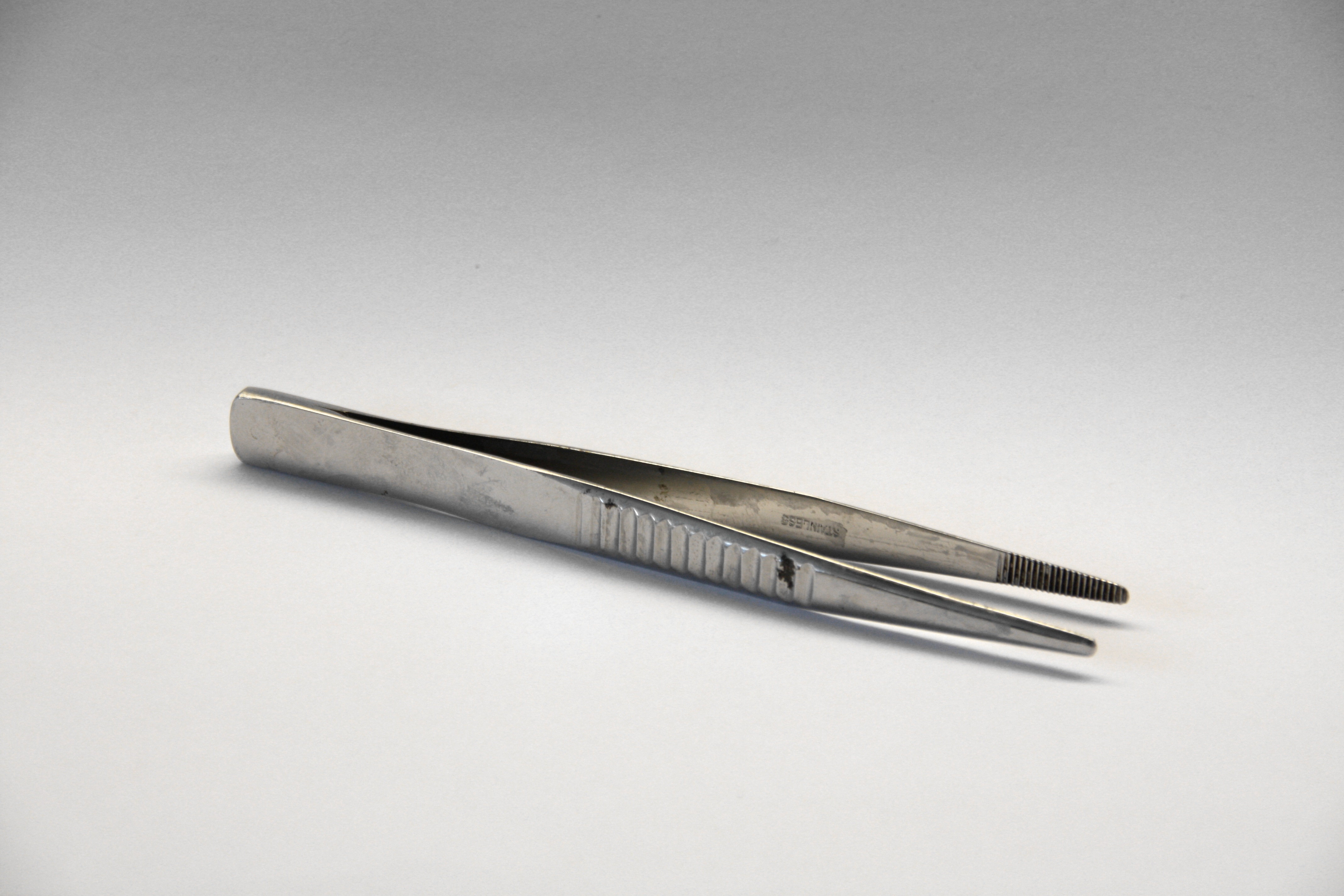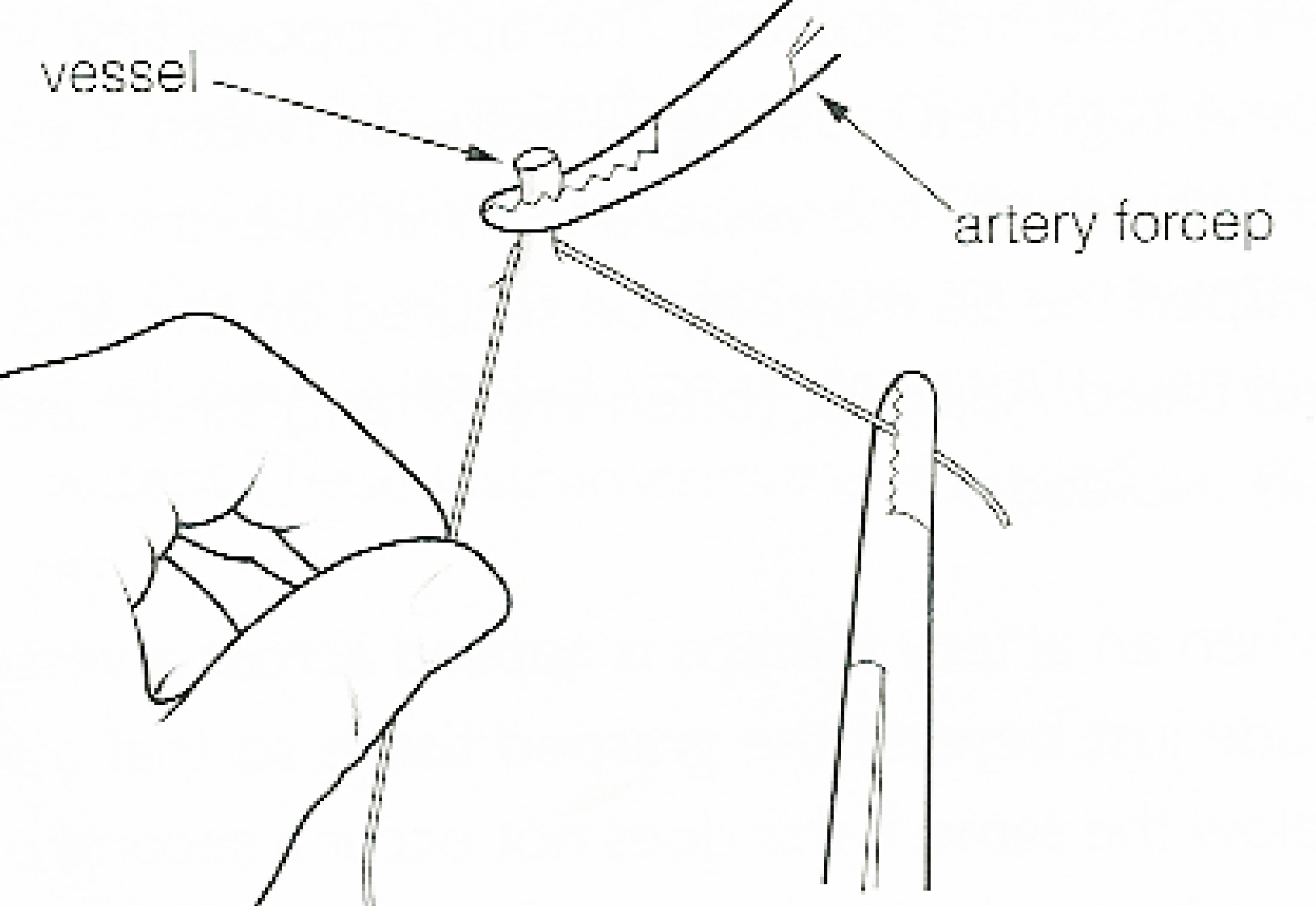|
Hemostat
A hemostat (also called a hemostatic clamp, arterial forceps, or pean after Jules-Émile Péan) is a surgical tool used in many surgical procedures to control bleeding. For this reason, it is common in the initial phases of surgery for the initial incision to be lined with hemostats which close blood vessels awaiting ligation. Hemostats belong to a group of instruments that pivot (similar to scissors, and including needle holders, tissue holders and various clamps) where the structure of the tip determines its function. The hemostat has handles that can be held in place by their locking mechanism. The locking mechanism is typically a series of interlocking teeth, a few on each handle, that allow the user to adjust the clamping force of the pliers. When locked together, the force between the tips is approximately 40 N (9 lbf). History The earliest known drawing of a pivoting surgical instrument dates back to 1500 BC on a tomb at Thebes, Egypt. Later Roman bronze and steel piv ... [...More Info...] [...Related Items...] OR: [Wikipedia] [Google] [Baidu] |
Hemostasis
In biology, hemostasis or haemostasis is a process to prevent and stop bleeding, meaning to keep blood within a damaged blood vessel (the opposite of hemostasis is hemorrhage). It is the first stage of wound healing. This involves coagulation, which changes blood from a liquid to a gel. Intact blood vessels are central to moderating blood's tendency to form clots. The endothelial cells of intact vessels prevent blood clotting with a heparin-like molecule and thrombomodulin, and prevent platelet aggregation with nitric oxide and prostacyclin. When endothelium of a blood vessel is damaged, the endothelial cells stop secretion of coagulation and aggregation inhibitors and instead secrete von Willebrand factor, which initiate the maintenance of hemostasis after injury. Hemostasis involves three major steps: * vasoconstriction * temporary blockage of a hole in a damaged blood vessel by a platelet plug * blood coagulation (formation of fibrin clots) These processes seal the injury or ho ... [...More Info...] [...Related Items...] OR: [Wikipedia] [Google] [Baidu] |
Kelly Forceps
Forceps (plural forceps or considered a plural noun without a singular, often a pair of forceps; the Latin plural ''forcipes'' is no longer recorded in most dictionaries) are a handheld, hinged instrument used for grasping and holding objects. Forceps are used when fingers are too large to grasp small objects or when many objects needed to be held at one time while the hands are used to perform a task. The term "forceps" is used almost exclusively in the fields of biology and medicine. Outside biology and medicine, people usually refer to forceps as tweezers, tongs, pliers, clips or clamps. Mechanically, forceps employ the principle of the lever to grasp and apply pressure. Depending on their function, basic surgical forceps can be categorized into the following groups: # Non-disposable forceps. They should withstand various kinds of physical and chemical effects of body fluids, secretions, cleaning agents, and sterilization methods. # Disposable forceps. They are usually made o ... [...More Info...] [...Related Items...] OR: [Wikipedia] [Google] [Baidu] |
Forceps
Forceps (plural forceps or considered a plural noun without a singular, often a pair of forceps; the Latin plural ''forcipes'' is no longer recorded in most dictionaries) are a handheld, hinged instrument used for grasping and holding objects. Forceps are used when fingers are too large to grasp small objects or when many objects needed to be held at one time while the hands are used to perform a task. The term "forceps" is used almost exclusively in the fields of biology and medicine. Outside biology and medicine, people usually refer to forceps as tweezers, tongs, pliers, clips or clamps. Mechanically, forceps employ the principle of the lever to grasp and apply pressure. Depending on their function, basic surgical forceps can be categorized into the following groups: # Non-disposable forceps. They should withstand various kinds of physical and chemical effects of body fluids, secretions, cleaning agents, and sterilization methods. # Disposable forceps. They are usually made o ... [...More Info...] [...Related Items...] OR: [Wikipedia] [Google] [Baidu] |
Jules-Émile Péan
Jules-Émile Péan (29 November 1830 – 20 January 1898) was one of the great French surgeons of the 19th century. Péan was born in 1830 in Marboué, french department of Eure-et-Loir. He studied at the college of Chartres and then studied medicine in Paris under Auguste Nélaton. He was appointed a doctor in 1861 and worked at St. Antoine and St. Louis up to 1893. He then created with its expenses the international hospital. He wrote two volumes of private clinics (1876 and 1890). He was elected to the French Académie Nationale de Médecine on November 22, 1887, and was awarded the rank of Commander of Legion of Honor in 1893. He died on January 20, 1898 in Paris. A street, Rue Péan, was named after him in Châteaudun, Cloyes-sur-le-Loir and Paris. Péan was very admired and a follower of hygiene, he disputed the discoveries of Louis Pasteur. He refused to dissect corpses and operated preferably in residence. Although a teacher, he was never named professor. He was t ... [...More Info...] [...Related Items...] OR: [Wikipedia] [Google] [Baidu] |
Ligature (medicine)
In surgery or medical procedure, a ligature consists of a piece of thread ( suture) tied around an anatomical structure, usually a blood vessel or another hollow structure (e.g. urethra) to shut it off. History The principle of ligation is attributed to Hippocrates and Galen. In ancient Rome, ligatures were used to treat hemorrhoids. The concept of a ligature was reintroduced some 1,500 years later by Ambroise Paré, and finally it found its modern use in 1870–80, made popular by Jules-Émile Péan. Procedure With a blood vessel the surgeon will clamp the vessel perpendicular to the axis of the artery or vein with a hemostat, then secure it by ligating it; i.e. using a piece of suture around it before dividing the structure and releasing the hemostat. It is different from a tourniquet in that the tourniquet will not be secured by knots and it can therefore be released/tightened at will. Ligature is one of the remedies to treat skin tag, or acrochorda. It is done by tying str ... [...More Info...] [...Related Items...] OR: [Wikipedia] [Google] [Baidu] |
Ligature (medicine)
In surgery or medical procedure, a ligature consists of a piece of thread ( suture) tied around an anatomical structure, usually a blood vessel or another hollow structure (e.g. urethra) to shut it off. History The principle of ligation is attributed to Hippocrates and Galen. In ancient Rome, ligatures were used to treat hemorrhoids. The concept of a ligature was reintroduced some 1,500 years later by Ambroise Paré, and finally it found its modern use in 1870–80, made popular by Jules-Émile Péan. Procedure With a blood vessel the surgeon will clamp the vessel perpendicular to the axis of the artery or vein with a hemostat, then secure it by ligating it; i.e. using a piece of suture around it before dividing the structure and releasing the hemostat. It is different from a tourniquet in that the tourniquet will not be secured by knots and it can therefore be released/tightened at will. Ligature is one of the remedies to treat skin tag, or acrochorda. It is done by tying str ... [...More Info...] [...Related Items...] OR: [Wikipedia] [Google] [Baidu] |
George Washington Crile
George Washington Crile (November 11, 1864 – January 7, 1943) was an American surgeon. Crile is now formally recognized as the first surgeon to have succeeded in a direct blood transfusion. He contributed to other procedures, such as neck dissection. Crile designed a small hemostatic forceps which bears his name; the Crile mosquito clamp. He also described a technique for using opioids, regional anesthesia and general anesthesia which is a concept known as balanced anesthesia. He is also known for co-founding the Cleveland Clinic in 1921. Early life Crile was born in Chili, Ohio. He graduated from Ohio Northern University in 1885. In 1887, he received his M.D. from Wooster Medical College which merged to form modern day Case Western Reserve University School of Medicine. He did further study at Vienna, London and Paris. Career He taught at Wooster from 1889 to 1900. He was professor of clinical medicine at Western Reserve University from 1900 to 1911, and was then made prof ... [...More Info...] [...Related Items...] OR: [Wikipedia] [Google] [Baidu] |
William Halsted
William Stewart Halsted, M.D. (September 23, 1852 – September 7, 1922) was an American surgeon who emphasized strict aseptic technique during surgical procedures, was an early champion of newly discovered anesthetics, and introduced several new operations, including the radical mastectomy for breast cancer. Along with William Osler (Professor of Medicine), Howard Atwood Kelly (Professor of Gynecology) and William H. Welch (Professor of Pathology), Halsted was one of the "Big Four" founding professors at the Johns Hopkins Hospital. His operating room at Johns Hopkins Hospital is in Ward G, and was described as a small room where medical discoveries and miracles took place. According to an intern who once worked in Halsted's operating room, Halsted had unique techniques, operated on the patients with great confidence and often had perfect results which astonished the interns. Throughout his professional life, he was addicted to cocaine and later also to morphine, which were no ... [...More Info...] [...Related Items...] OR: [Wikipedia] [Google] [Baidu] |
Thomas Spencer Wells
Sir Thomas Spencer Wells, 1st Baronet (3 February 181831 January 1897) was surgeon to Queen Victoria, a medical professor and president of the Royal College of Surgeons of England. Early life He was born at St Albans, Hertfordshire and received his early education at St Albans School (then located in the Lady Chapel of the Abbey). Career After a short time as a pupil of a surgeon in Barnsley (Yorkshire), he studied medicine at Leeds, Trinity College Dublin, St Thomas' Hospital (becoming a Member of the Royal College of Surgeons ( MRCS) in 1841 and a Fellow (FRCS) in 1844), and later in Paris, France. He served as a naval surgeon in Malta, and then established his own ophthalmic surgery practice in London in 1853. In the same year he married Elizabeth Wright. In 1854, and from 1856 to 78, he was surgeon of the Samaritan Free Hospital for Women, London (serving in between as an army surgeon in the Crimean War). He also lectured at the Grosvenor School of Medicine (which ... [...More Info...] [...Related Items...] OR: [Wikipedia] [Google] [Baidu] |
Emil Theodor Kocher
Emil Theodor Kocher (25 August 1841 – 27 July 1917) was a Swiss physician and medical researcher who received the 1909 Nobel Prize in Physiology or Medicine for his work in the physiology, pathology and surgery of the thyroid. Among his many accomplishments are the introduction and promotion of aseptic surgery and scientific methods in surgery, specifically reducing the mortality of thyroidectomies below 1% in his operations. He was the first Swiss citizen and first surgeon to ever receive a Nobel Prize in Medicine. He was considered a pioneer and leader in the field of surgery in his time. Early life and personal life Childhood Kocher's father was Jakob Alexander Kocher (1814–1893), the sixth of seven children to Samuel Kocher (1771–1842), a carpenter, and Barbara Sutter (1772–1849). Jakob Alexander Kocher was a railway engineer and he moved in 1845 to Burgdorf, Switzerland (near Bern), because of his job as regional engineer of Emmental (''Bezirksingenieur''). He ... [...More Info...] [...Related Items...] OR: [Wikipedia] [Google] [Baidu] |
Ambroise Paré
Ambroise Paré (c. 1510 – 20 December 1590) was a French barber surgeon who served in that role for kings Henry II, Francis II, Charles IX and Henry III. He is considered one of the fathers of surgery and modern forensic pathology and a pioneer in surgical techniques and battlefield medicine, especially in the treatment of wounds. He was also an anatomist, invented several surgical instruments, and was a member of the Parisian barber surgeon guild. In his personal notes about the care he delivered to Captain Rat, in the Piémont campaign (1537–1538), Paré wrote: ''Je le pansai, Dieu le guérit'' ("I bandaged him and God healed him"). This epitomises a philosophy that he used throughout his career. These words, inscribed on his statue in Laval, are reminiscent of the Latin adage '' medicus curat, natura sanat''. Early life Paré was born in 1510 in Bourg-Hersent, near Laval, then part of the province of Maine, in northwestern France. As a child he watched, and was fir ... [...More Info...] [...Related Items...] OR: [Wikipedia] [Google] [Baidu] |








